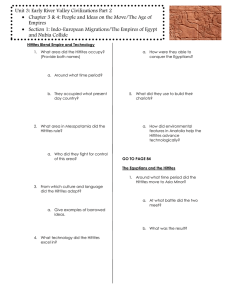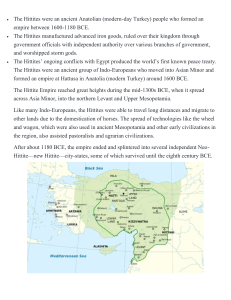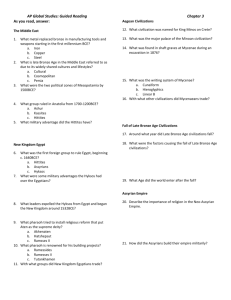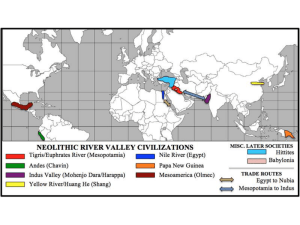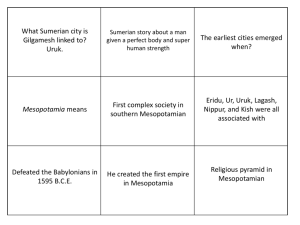H ITTITES MEET THE…
advertisement
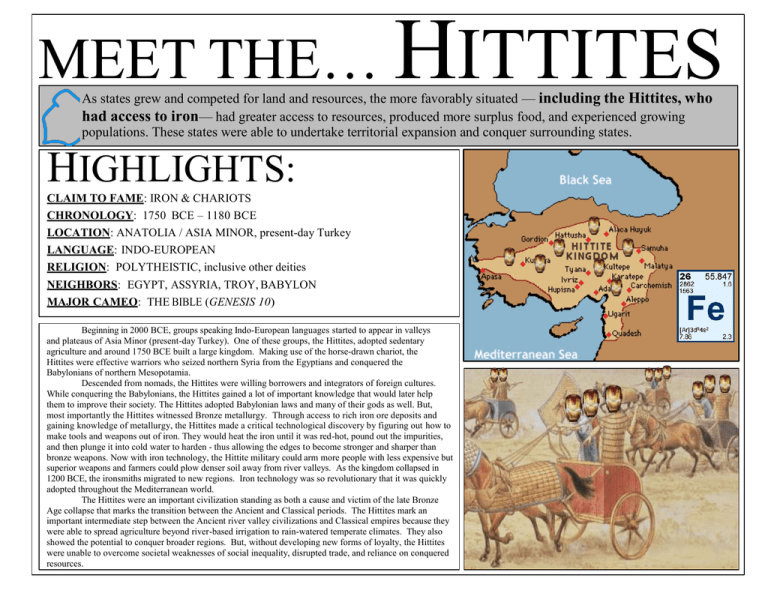
MEET THE… HITTITES As states grew and competed for land and resources, the more favorably situated — including the Hittites, who had access to iron— had greater access to resources, produced more surplus food, and experienced growing populations. These states were able to undertake territorial expansion and conquer surrounding states. HIGHLIGHTS: CLAIM TO FAME: IRON & CHARIOTS CHRONOLOGY: 1750 BCE – 1180 BCE LOCATION: ANATOLIA / ASIA MINOR, present-day Turkey LANGUAGE: INDO-EUROPEAN RELIGION: POLYTHEISTIC, inclusive other deities NEIGHBORS: EGYPT, ASSYRIA, TROY, BABYLON MAJOR CAMEO: THE BIBLE (GENESIS 10) Beginning in 2000 BCE, groups speaking Indo-European languages started to appear in valleys and plateaus of Asia Minor (present-day Turkey). One of these groups, the Hittites, adopted sedentary agriculture and around 1750 BCE built a large kingdom. Making use of the horse-drawn chariot, the Hittites were effective warriors who seized northern Syria from the Egyptians and conquered the Babylonians of northern Mesopotamia. Descended from nomads, the Hittites were willing borrowers and integrators of foreign cultures. While conquering the Babylonians, the Hittites gained a lot of important knowledge that would later help them to improve their society. The Hittites adopted Babylonian laws and many of their gods as well. But, most importantly the Hittites witnessed Bronze metallurgy. Through access to rich iron ore deposits and gaining knowledge of metallurgy, the Hittites made a critical technological discovery by figuring out how to make tools and weapons out of iron. They would heat the iron until it was red-hot, pound out the impurities, and then plunge it into cold water to harden - thus allowing the edges to become stronger and sharper than bronze weapons. Now with iron technology, the Hittite military could arm more people with less expensive but superior weapons and farmers could plow denser soil away from river valleys. As the kingdom collapsed in 1200 BCE, the ironsmiths migrated to new regions. Iron technology was so revolutionary that it was quickly adopted throughout the Mediterranean world. The Hittites were an important civilization standing as both a cause and victim of the late Bronze Age collapse that marks the transition between the Ancient and Classical periods. The Hittites mark an important intermediate step between the Ancient river valley civilizations and Classical empires because they were able to spread agriculture beyond river-based irrigation to rain-watered temperate climates. They also showed the potential to conquer broader regions. But, without developing new forms of loyalty, the Hittites were unable to overcome societal weaknesses of social inequality, disrupted trade, and reliance on conquered resources.
